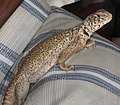Top Qs
Timeline
Chat
Perspective
Uromastyx
Genus of lizards From Wikipedia, the free encyclopedia
Remove ads
Uromastyx is a genus of lizards in the family Agamidae. The genus is native to Africa and the Middle East (West Asia). Members of the species are commonly called spiny-tailed lizards, uromastyces, mastigures, or dabb lizards.
This article needs additional citations for verification. (July 2023) |
Lizards in the genus Uromastyx are primarily herbivorous, but occasionally eat insects and other small animals, especially young lizards. They spend most of their waking hours basking in the sun, hiding in underground chambers at nighttime or when danger appears. They tend to establish themselves in hilly, rocky areas with good shelter and accessible vegetation.
Remove ads
Taxonomy
Summarize
Perspective
The generic name Uromastyx is derived from the Ancient Greek words οὐρά (ourá), meaning "tail", and μάστιξ (mástix), meaning "whip" or "scourge", after the thick-spiked tail characteristic of all Uromastyx species.[2]
Species
The following species are in the genus Uromastyx.[3] Three additional species were formerly placed in this genus, but have been moved to their own genus, Saara.[3][4]
Nota bene: A binomial authority in parentheses indicates that the species was originally described in a genus other than Uromastyx.
Remove ads
Description
Uromastyx species range in size from 25 cm (10 in) for U. macfadyeni to 91 cm (36 in) or more for U. aegyptia. Hatchlings or neonates are usually no more than 7–10 cm (3–4 in) in length.[citation needed] Like many reptiles, these lizards' colors change according to the temperature and season.[6] During cool weather they appear dull and dark, but the colors become lighter in warm weather, especially when basking. The darker pigmentation allows their skin to absorb sunlight more effectively.
Their spiked tail is muscular and heavy, and is able to be swung at an attacker with great velocity, usually accompanied by hissing and an open-mouthed display of (small) teeth.[7] Uromastyx generally sleep in their burrows with their tails closest to the opening, in order to thwart intruders.[7]
Remove ads
Distribution
Uromastyx inhabit a range stretching through most of North and Northeast Africa, the Middle East, ranging as far east as Iran. Species found further east are now placed in the genus Saara.[4] Uromastyx occur at elevations from sea level to well over 900 m (3,000 ft). They are regularly eaten, and sold in produce markets, by local peoples.
Diet
Uromastyx lizards acquire most of the water they need from the vegetation they ingest.[citation needed] In the wild they generally eat any surrounding vegetation. When hatching, baby Uromastyx eat their own mother's feces as their first meal before heading off to find a more sustainable food source. They do this to establish a proper gut flora, essential for digesting the plants that they eat.
In the wild, adult U. dispar maliensis have been reported to eat insects at certain times of the year, when it is hot and their only food source available would be insects.[citation needed]
Remove ads
Reproduction
A female Uromastyx can lay anywhere from 5 to 40 eggs, depending on age and species. Eggs are laid approximately 30 days following copulation with an incubation time of 70–80 days.[8] The neonates weigh 4–6 g (0.14–0.21 oz) and are about 5 cm (2 in) snout to vent length.[8] They rapidly gain weight during the first few weeks following hatching.[8]
A field study in Algeria concluded that Moroccan spiny-tailed lizards add approximately 5 cm (2 in) of total growth each year until around the age of 8–9 years.[8]
Wild female Uromastyx are smaller and less colorful than males. For example, U. dispar maliensis females are often light tan with black dorsal spots, while males are mostly bright yellow with mottled black markings. Females also tend to have shorter claws.[citation needed] In captivity female U. dispar maliensis tend to mimic males in color.[9] U. dispar maliensis are, therefore, reputably difficult to breed in captivity.
Remove ads
Relationship with humans
Summarize
Perspective

Captivity
Uromastyx are removed from the wild in an unregulated manner for the pet and medicinal trade in Morocco, despite their protected status in the country; conditions of the animals while being sold is often extremely poor and overcrowding is common.[10] Historically, captive Uromastyx had a poor survival rate, due to a lack of understanding of their dietary and environmental needs.[citation needed] In recent years, knowledge has significantly increased, and appropriate diet and care has led to survival rates and longevity approaching and perhaps surpassing those in the wild.[citation needed] With good care, they are capable of living for over 25 years, and possibly as old as 60.
Consumption by humans
U. dispar maliensis, known as "ḍabb" (Arabic: ضَـبْ) by peninsular Arabs, is historically consumed as food by some of the Bedouin population of the Arabian peninsula, mainly those residing in the interior and eastern regions of Arabia.[11][12][13][14] This lizard used to be considered an "Arabian delicacy".[15] It is recorded that when an Uromastyx was brought to the Islamic prophet Muhammad by Bedouins, Muhammad did not eat the lizard, but Muslims were not prohibited by him from consuming it; thus Muhammad's companion Khalid bin Walid consumed the lizard.[16][17][18][19]
In Judaism, this lizard is traditionally identified as the biblical tzav, one of the eight "creeping" animals forbidden for consumption that impart ritual impurity. The Torah states: "The following shall be impure for you among the creeping animals that swarm upon the earth: The weasel, and the mouse, and the dab lizard (tzav) of every variety; and the gecko, and the land-crocodile, and the lizard, and the skink, and the chameleon" (Leviticus 11:29–30).[20]
Remove ads
See also
References
External links
Wikiwand - on
Seamless Wikipedia browsing. On steroids.
Remove ads











